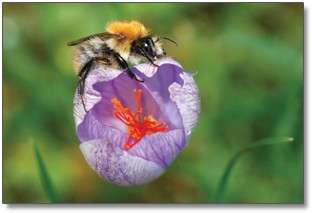Bees and Flowers Communicate Using Electric Fields
By Samba Lampich
Flowers use their colors, size, shape and smell to attract pollinators. But scientists say they may also be giving off an electric vibe to maximize their attraction to bees. Researchers Daniel Robert, Dominic Clarke and Heather Whitney from the University of Bristol have shown that flowers use electric fields to attract bumblebees.
The Power of Attraction
The science community has long known that flowers growing in the ground have a natural negative charge. Bees, on the other hand, are positively charged. This is because the friction between tiny air particles and the bees cause them to lose electrons leaving them with a positive charge.
What remained unknown was whether the electricity between the bees and flowers was mutually beneficial. Did bees notice the electric fields and use it to choose flowers?
To find out, the scientists set up an experiment by building a small arena full of fake purple flowers consisting of a stalk and small dish at the top. Half the flowers were wired to create a small electric field and the other half were not. The wired flowers held sugar water and the unwired ones held quinine, a substance bees find unpleasant.

Photo Credit: Fir0002/Flagstaffotos
When bumblebees were released into the fake flower patch when no flower had an electric charge, the researchers found that the bees visited the flowers randomly. They landed on the sugary flowers as often as on the quinine filled ones. But when a small electric charge was released into the sugar-filled flowers, the bees learned to visit them with 81% accuracy. When the charge was removed, the bees went back to randomly visiting flowers.
Nature’s Billboards
Roberts and his fellow researchers studied real petunias and measured the electric field around the flower before and after a bee visited it. They found that a flower’s electric field increased in charge as a bee approached and the boost remained for about 100 seconds after the bee had gathered nectar and left.
Roberts believes that this lingering charge helped to inform other bees that the plant had no more nectar and that they should find another flower. This way, the bees are not wasting their efforts and the flowers can replenish their supply in peace.
Classroom Discussion
- How can noise and air pollution affect pollination? Consider the effect on the pollinators themselves.
- How does the use of pesticides affect fruit and vegetable farmers?